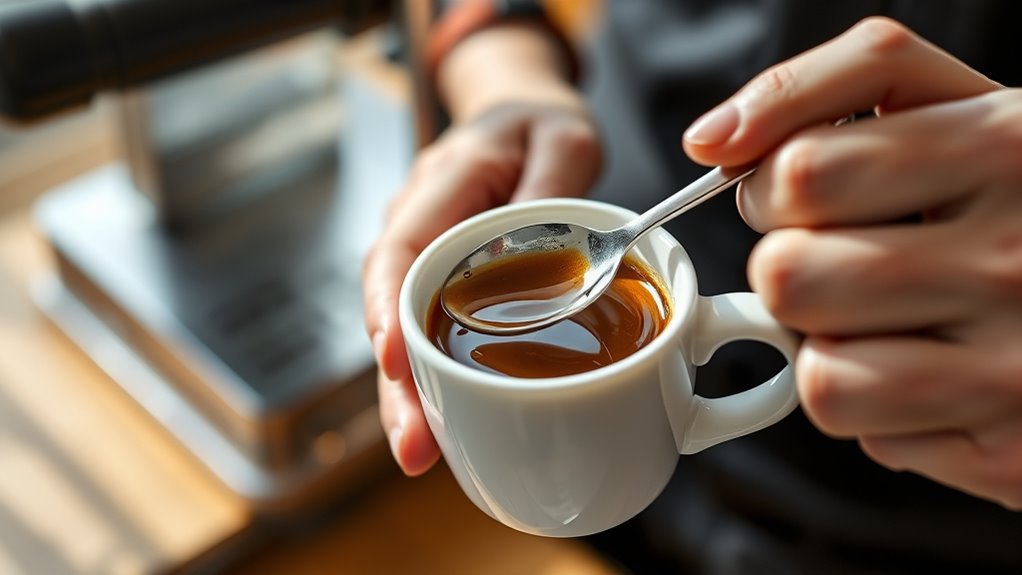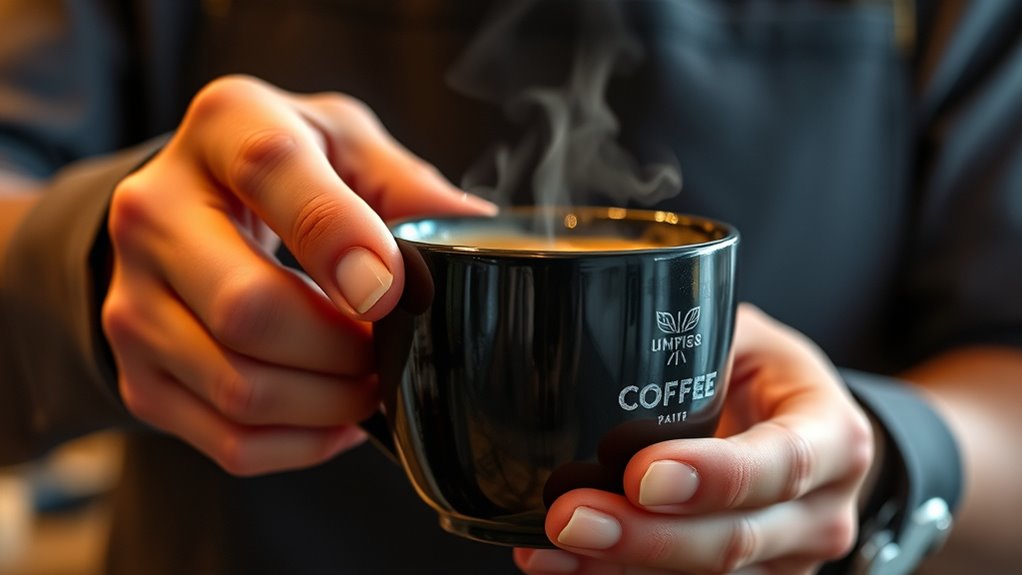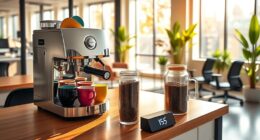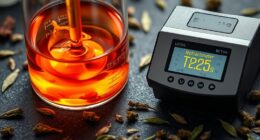To cup coffee like a pro, start by weighing 20 grams of coffee and grinding it to a coarse, sea salt-like consistency. Use multiple cupping bowls and fill each with about 150 grams of hot water at 200°F. Let it steep for four minutes, then gently break the crust to release aromas while inhaling deeply. Slurp to aerate the coffee and notice flavor nuances. Maintaining consistency and cleanliness is key—keep practicing to refine your palate and develop expert-level skills.
Key Takeaways
- Measure and grind coffee precisely to a coarse, sea salt-like consistency for consistency across samples.
- Use hot water at 200°F and steep for four minutes, observing crust formation and aroma development.
- Gently break the crust to release aromatics, inhaling deeply to evaluate wet aroma nuances.
- Skim grounds carefully, then slurp to aerate and assess flavor complexity and evolution.
- Maintain cleanliness and consistency by rinsing utensils and following standardized procedures for accurate comparison.

Cupping coffee like a pro requires attention to detail and consistent technique. This process isn’t just about tasting; it’s about systematically evaluating the complex flavor notes and aromas that define each coffee. When you start, measure exactly 20 grams of coffee and grind it to a coarse, sea salt-like consistency. Using multiple cupping bowls per sample helps guarantee accuracy and allows you to compare dry fragrance, wet aroma, and flavor profiles side by side. This standardized method, favored by coffee professionals, guarantees that each cupping session produces reliable, comparable results. Once your grounds are in the cupping bowls, pour approximately 150 grams of hot water at about 200°F over the coffee. You’ll want to let the coffee steep for around four minutes. During this time, the coffee grounds will float to the top, forming a crust. Breaking this crust is a key step—using a spoon, gently push down and break the surface. This releases the full range of aromatics and provides an immediate sensory experience. As the crust breaks, inhale deeply to assess the wet aroma, noting the scent’s complexity and nuances. Take your time to evaluate these aromatic qualities, which reveal important sensory notes about the coffee’s origin and roast profile. After breaking the crust, carefully skim off any remaining grounds and foam before tasting. When it’s time to sample, slurp the coffee from a spoon. This aerates the liquid and helps spread the flavors evenly across your palate. As you taste, pay close attention to the flavor notes and how they evolve. Note any differences between samples, especially when comparing single origin coffees, which often showcase distinctive profiles. Recording detailed sensory notes is essential for tracking different coffees’ unique qualities, from acidity and body to specific flavor nuances. Maintaining a clean setup throughout the process is vital. Rinse your spoons between tastings to prevent cross-contamination of flavors. This consistency allows you to focus solely on the coffee’s intrinsic qualities. Additionally, understanding the cultural significance of Aboriginal traditions, such as storytelling and art, can deepen your appreciation for the rich heritage behind each coffee’s origin story. As you develop your palate, you’ll find that the act of cupping becomes more intuitive, revealing subtle distinctions and enhancing your appreciation for coffee’s complexity. Whether you’re a budding enthusiast or an experienced professional, adhering to this standardized method guarantees your tasting coffee sessions are precise, informative, and enjoyable.
Frequently Asked Questions
How Do You Make the Perfect Cup of Coffee?
To make the perfect cup of coffee, start with fresh, high-quality beans and grind them just before brewing.
Measure your coffee and water carefully, aiming for a ratio of about 1:15 to 1:18.
Use clean, filtered water heated to 195-205°F, and steep the grounds for 3-4 minutes.
Pour immediately after brewing, so you enjoy the rich aroma and flavor at its peak.
How Do Professionals Taste Coffee?
You taste coffee by first smelling the dry and wet aromas, then slurping it to aerate and reveal flavors. Pay close attention to the flavor notes, body, acidity, and aftertaste, comparing multiple samples side-by-side.
Take detailed notes on each aspect, focusing on what stands out. This method helps you evaluate the coffee’s quality, balance, and unique characteristics, just like a professional cupping session.
How Do You Judge a Good Cup of Coffee?
When judging a good cup of coffee, you focus on its aroma, flavor, and mouthfeel. You want balanced notes without off-flavors or defects, noticing a pleasing sweetness that contrasts with any bitterness.
Pay attention to how smooth and lingering the finish is, ensuring it’s not harsh or astringent. Your goal is to evaluate consistency, extraction, and roast level, all of which contribute to a well-rounded, enjoyable coffee experience.
What Is the Best Ratio for Coffee Cupping?
The best ratio for coffee cupping is generally 8.25 grams of coffee to 150 ml of water, or about 1:18. This ratio provides a balanced extraction, highlighting the coffee’s aroma and flavor.
You should measure precisely with a scale to guarantee consistency across samples. Some professionals prefer 55 grams per liter, which simplifies to roughly 8.25 grams per 150 ml cup, giving reliable and comparable results.
Conclusion
Now that you know how to cup coffee like a pro, practice regularly to refine your palate. Remember, tasting is about more than just the flavor—pay attention to aroma, body, and aftertaste. Trust your senses and take notes to track your preferences. With time and experience, you’ll develop a keen palate that can distinguish the finest nuances. Keep exploring different beans and roasts, and enjoy the journey of becoming a true coffee connoisseur.









